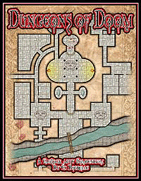
|
About OgreCave and its staff
|

|
by Matthew Pook
One of the most attractive books published last year was Todd Gamble’s Cartographica, a beautiful collection of maps painted in full color. Each piece came unadorned, ready for the DM to provide the details: the traps, the NPCs, the treasures, and so on. Those maps, with their Italianate style, could be used for any fantasy RPG, not just Dungeons & Dragons. For the follow up, Green Ronin has turned to another cartographer to create the publisher’s second map collection, one that is much more suited for use with the world’s leading fantasy RPG. Ed Bourelle, whose work has graced the pages of supplements for Monte Cook’s Arcana Unearthed, Dragonlance, Midnight and others, is the artist behind Dungeons of Doom: A Compendium of Fantasy Maps. The collection is longer than Todd Gamble’s Cartographica and there are more maps, this time done in black and white rather than color. The lack of color is not a handicap, though: produced in light grey shades, every map is clear and easier to read than the earlier volume. Further, the maps are all very clearly marked and labelled. This contributes to the ease of use, and also the referee’s own creativity as the maps are also built around certain themes and places. The first is the “Dungeon Kingdom,” a series of small communities located between two underground river systems. These start out with a “Cave Town,” which provides the major access to the kingdom, it is surrounded by “Fungus Farms” that provide sustenance, a “River Town,” and the home of the kingdom’s ruler, the “Dungeon Keep.” Besides the organized societies found in the towns, more primitive peoples can be found in the “Tribal Cavern” (mislabelled on the maps as the “Primitive Caverns”), and also a fair sized three-level “Kobold Lair.” Barring the numbers and the names, this is a ready-to-play location, one that could become a unique location in a DM’s campaign world, or because its many communities have retreated underground in the face of the devastating Lunar Rain, be dropped straight into the DragonMech setting published by Goodman Games. The second theme maps are provided for is “The Great Cave Lake,” which could be located beyond the “Dungeon Kingdom.” The deepest part of the lake contains an elemental vortex, while “The Ghoul King’s Tower,” which runs from the surface of the lake several stories up to the ceiling, dominates the shallow part. Six towering Guard Posts that hang out over the lake surround it. Along the walls are a “City of Serpents,” a “Fungus Jungle,” and a “City of Spiders.” Some locations like the “Crystal Domain” defy description, but the DM will just have to be creative. “Fire Top Peak,” the third set of maps, feels like a nod to the classic Advanced Dungeons & Dragons adventure, S2: White Plume Mountain, but is in fact home to a set of dwarven ruins and mines. Located in the walls of a volcano, these have been partially flooded by magma flows. Deep inside the volcano is located a “Furnace Of The Fire Giants,” and below that is the “Temple Of The Efreeti” which juts up 50 feet out of a lake of fire! After these three series of connected maps, the last two sections are split between tombs and labyrinths. All of these are singular pieces, devoted to particular species, such as Frost Giants or Goblins, or individuals, such as a mage or a pharaoh. The labyrinths are a reasonable mix of mazes and small complexes. Some of the labyrinths, as well as the City of Serpents and Dwarven City, come in undetailed second versions, ready to use as player handouts.
Conclusions On the downside, some might suggest that a book of maps like this is too expensive. Perhaps it is too pricey for a book of maps, but this is a very nice collection. Though Todd Gamble’s Cartographica was prettier overall, Dungeons of Doom: A Compendium of Fantasy Maps is certainly more serviceable and evocative.
|
||
 Dungeons of Doom: A Compendium of Fantasy Maps
Dungeons of Doom: A Compendium of Fantasy Maps